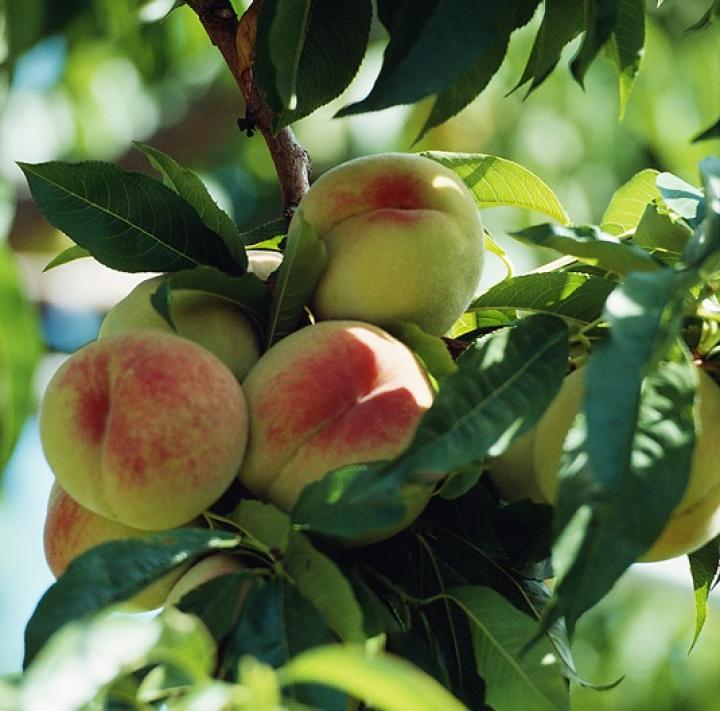
Peaches are a well-known, delicious fruit that can be grown right at home. The trick to growing your very own peaches is to choose a type that will fit with your specific climate.
Planting
- Peach trees can grow in USDA Zones 5 to 8, but do especially well in Zones 6 and 7.
- If you live in one of these zones, you can focus on choosing a variety based on its flavor and harvest-time. If you live in colder regions, there are some varieties that are more cold tolerant that you can choose.
- Choose a site with well-drained, moderately fertile soil in full sun. Be sure to avoid low areas because frost can more easily settle there and destroy your peaches.
- Plant the trees in spring. It is best to plant the trees the day you get them (if possible). Pick a tree that is about 1 year old.
- For container-grown trees, remove the plant from its pot and remove any circling roots by laying the root ball on its side and using shears to cut through the roots.
- For grafted trees, position the inside of the curve of the graft union away from the sun when planting.
- Dig a hole that is a few inches deeper and wider than the spread of the roots. Set the tree on top of a small mound of soil in the middle of the hole. Be sure to spread the roots away from the trunk without excessively bending them.
- If you are planting standard-size trees, space them 15 to 20 feet apart. Space dwarf trees 10 to 12 feet apart. However, most types of peach trees are self-fertile, so planting one tree at a time is fine.
Care
- About 6 weeks after planting, fertilize the young trees with 1 pound of a nitrogen fertilizer.
- During the second year, add ¾ pound of nitrogen fertilizer once in the spring and once in the early summer.
- After the third year, add about 1 pound of actual nitrogen per year to the mature trees in the spring.
- To help make the tree hardier, do not fertilize it within 2 months of the first fall frost date or when the fruits are maturing.
- Be sure to prune the tree to an open center shape. In the summer of the first year, cut the vigorous shoots that form on the top of the tree by two or three buds. After about a month, check the tree. As soon as you have three wide-angled branches, spaced equally apart, cut back any other branches so that these three are the main branches. In the early summer of the second year, cut back the branches in the middle of the tree to short stubs and prune any shoots developing below the three main branches. After the third year, remove any shoots in the center of the tree to keep its shape.
- Be sure to prune the tree annually to encourage production. Pruning is usually done mid to late April. Pinching the trees in the summer is also helpful.
- Prune and fertilize to accomplish 10-18 inches of new growth each season.
- Thin the fruits so that they are 6 to 8 inches apart on the branch after the tree blooms (about 4 to 6 weeks). This ensures that the fruits will be larger.
- A plastic lean-to can protect fan-trained peach trees from peach leaf curl and frost in the winter.
- To help increase resistance to fruit diseases, be sure to prune the trees, thin the fruit, and pick the fruit when it is ripe.
Pests/Diseases
- Borers
- Aphids
- Japanese beetles
- Leaf hoppers
- Brown rot
- Powdery mildew
- Leaf curl
- Mosaic viruses
Harvest/Storage
- Harvest your peaches when they are fully ripe, meaning that there is no green left on the fruit. They should come off the tree with only a slight twist. The fruits found on the top and outside of the tree usually ripen first.
- Be careful when picking your peaches because some varieties bruise very easily.
- You can store peaches in the refrigerator in a plastic bag. They should keep for about 5 days.
- You can also store peaches by making jam or by making pickled peaches.
- Peaches can also be canned or kept frozen for storage.
Recommended Varieties
- ‘Redhaven’, which is the standard and most popular choice. These peaches are medium-size, but can be small if the tree is not properly thinned. Its skin is tough and firm and red in color.
- ‘Reliance’, which is a hardy variety. It produces small and soft fruits.
- ‘Harmony’ (‘Canadian Harmony’), which is winter hardy and moderately resistant to bacterial leaf spot. It produces medium to large fruit and freezes well.
- Some zone favorites are:
4
5
6
7
8
9
10
Hale
Madison
Saturn
Contender
Frost
Topaz
Florida Beauty
Wit & Wisdom
Although peaches are native to the Chinese countryside, the peach was brought to the western world from Iran.
Peaches ripen faster in a closed paper bag at room temperature.
Test buds of peaches and other sensitive fruits for freeze damage. Bring in a few twigs cut from the trees and place them in a vase of water. If the twigs bloom in a week or two, expect blossoms in the spring and a crop the following fall.
Recipes
- Peach Cobbler
- Peach Jam
- Brandied Peach Ice






